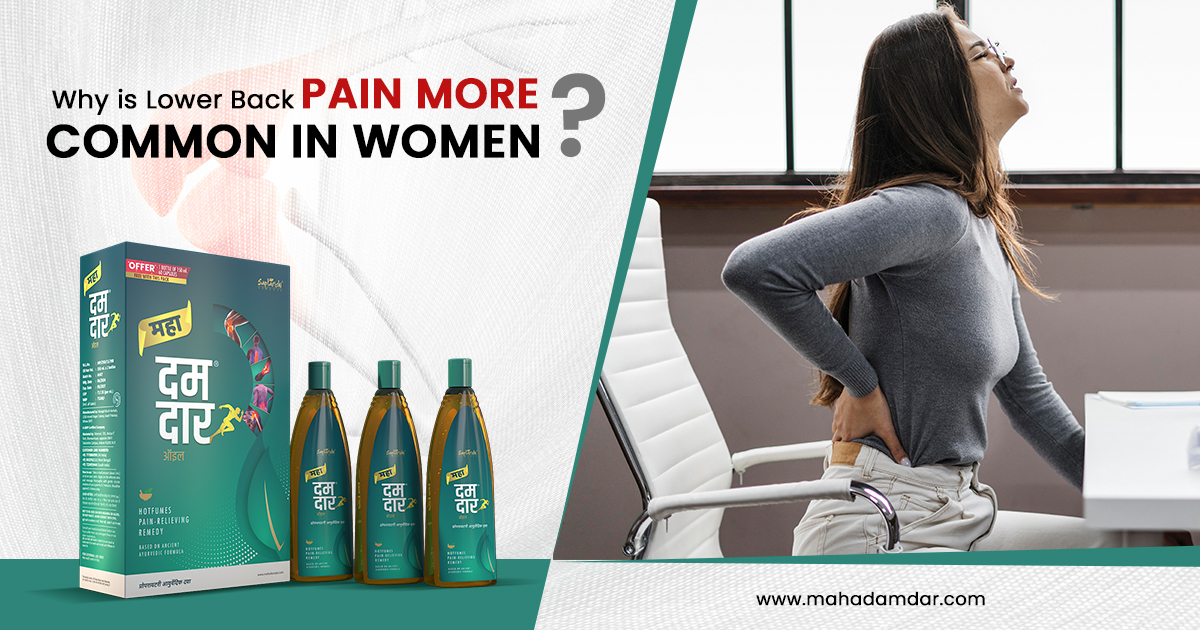Why is Lower Back Pain More Common in Women?

Almost every woman would have experienced lower back pain in her lifetime, if lucky, not very often, but at least a few times in her whole life. It may sometimes be a dull ache, sometimes a sharp or shooting pain. Though both men and women can suffer from back pain, some causes are more specific to women because of their differences in lifestyle, physiology, and hormones.
Let’s understand the most common factors why women experience lower back pain more often than men and what they could do about it.
Ayurveda’s Take on Lower Back Pain
Ayurveda believes that aggravation of vata dosha leads to joint pain, which in women is due to hormonal fluctuations, excessive physical activities, childbirth, irregular eating habits, or stress.
Ayurveda terms different types of back pain with the following names:
- Vata disorder affecting the lower back: Kati vata
- Imbalance in pelvic vata function: Apana vata dushti
- Vata-related joint degeneration: Sandhigata vata
- Pain in lower back: Kati Shoola
- Joint pain due to toxin buildup: Ama vata
Lifestyle-Related Causes
Many women live a busy life today, and multitasking takes a toll on the body. Bad posture at work, regularly wearing high heels, carrying heavy bags on one side, or carrying children leads to muscular imbalances and lower back strain over time.
On the other hand, lack of core strength due to inactivity, skipping meals, excess travel, and exposure to cold weather can be other reasons for lower back pain.
Ayurveda mentions these as some of the common mistakes that disturb Vata and cause back pain.
Stress and Emotional Load
Mental and emotional stress that women carry often shows up physically. They can make your back and neck muscles stiff, increasing pain sensitivity. Poor sleep due to stress also affects the recovery of muscles. It sounds strange, but lower back pain can be a result of emotional and physical stress.
Stress affects the nervous system (majja dhatu) and weakens vital energies, making the back more prone to pain.
Bone Health
Women are at higher risk of suffering from weak and brittle bones. Hormonal changes during menopause worsen bone health. Poor posture, stooped back, or shrinking height are some of the symptoms of poor bone health.
Pregnancy-Related Back Pain
As per the study done in December 2023 , at least 70% of women suffer from back pain during pregnancy, which inhibits their daily activities. Hormonal changes, especially relaxin (a hormone), weight gain, and reduced capacity to bear weight, are some of the reasons for back pain during pregnancy.
Apana vata governs childbirth, menstruation, bowel movement, and urination. Disturbed Apana vata causes back pain during menstruation or ovulation.
This may be followed by post-partum (after delivery) lower back pain, when vata increases naturally. The other factors leading to back pain are hormonal changes, lifting the baby, poor posture, or weak pelvic floor muscles.
Toxin Buildup
When toxins or ama accumulate in the body, they settle in the spine, joints, and pelvic area, causing stiffness, heaviness, and pain that may worsen during periods of inactivity. Ayurveda calls this ama-vata-related pain when both ama or toxin and vata are involved.
Ayurvedic Solution for a Pain-Free Lower Back
Ayurveda recommends a few solutions to treat lower back pain in women.
Calming Vata
Oil massage is one of the vata-pacifying therapies. In Ayurveda, oil massage is known as Abhyanga, and is done with warm medicated oils like Mahanarayan Taila, Kottamchukkadi Taila, Sandhi Sudha Oil, or Damdar Oil.
Medicated enema is believed to be the best treatment for vata imbalance.
Steam therapy or Swedana, relieves stiffness and improves blood circulation. Damdar Oil is an ayurvedic hotsteam joint pain relief oil that is perfect for Abhyanga and Swedana.
Also, try Mahadamdar oil for quick joint pain relief.
Herbs and Remedies
- Dashmoola relieves Vata pain and inflammation
- Guggul, Rasna, and Eranda are excellent for joint and back issues
- Ashwagandha is well-known for its nerve and muscle-strengthening properties.
- Shatavari balances hormones and supports women’s health
Diet and Lifestyle
- Warm and nourishing foods like khichdi, ghee, soups
- Avoid cold, dry, and processed foods
- Rest during menstruation and proper Abhyanga and Swedana during post-natal care.
- Gentle yoga for Apana Vata (like Pawanmuktasana, Bhujangasana)
- Meditation and breathing for stress relief
Final Thoughts
Lower back pain in women is not just a structural or physiological issue but a deeper imbalance in vata and factors related to hormones, posture, lifestyle, stress, and emotional load. As per Ayurveda, the subtype Apana Vata plays a vital role in lower back pain in women.
Ayurveda provides a viable solution for relief from joint pain, which includes vata-pacifying therapies, herbal remedies, lifestyle, and diet changes. Oil massages with ayurvedic oils like Damdar oil, Sandhi Sudha oil, Mahanarayan oil, etc., as part of Abhyanga therapy, are the best remedy for improving blood circulation, lubricating joints and muscles, improving flexibility, and gaining relief from joint pain.
